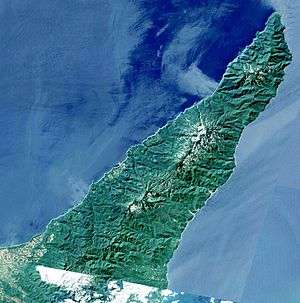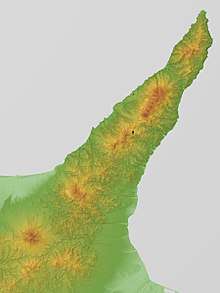Shiretoko Peninsula
Shiretoko Peninsula (知床半島, Shiretoko-hantō) is located on the easternmost portion of the Japanese island of Hokkaidō, protruding into the Sea of Okhotsk. It is separated from Kunashir Island of Russia by the Nemuro Strait. The name Shiretoko is derived from the Ainu word sir etok, meaning "the end of the Earth"[1] or "the place where the Earth protrudes". The towns of Rausu and Shari are found on the peninsula.
| Shiretoko Peninsula | |
|---|---|
 A satellite image of Shiretoko Peninsula | |
| Highest point | |
| Peak | Mount Rausu, Shari and Rausu |
| Elevation | 1,661 m (5,449 ft) |
| Coordinates | 44°4′33″N 145°7′21″E |
| Dimensions | |
| Length | 70 km (43 mi) SW-NE |
| Width | 25 km (16 mi) NW-SE |
| Area | 1,230 km2 (470 sq mi) |
| Naming | |
| Etymology | Ainu sir etok, "the end of the Earth" or "the place where the Earth protrudes" |
| Native name | Shiretoko-hantō (知床半島) |
| Geography | |
 Northeastern corner of the archipelago
| |
| Country | Japan |
| State | Hokkaidō |
| Regions | Abashiri Subprefecture and Nemuro Subprefecture |
| Districts | Menashi District, Shari District and Shibetsu District |
| Range coordinates | 44°5.8′N 145°9.2′E |
| Geology | |
| Orogeny | island arc |
| Type of rock | Volcanic |
| Climbing | |
| Official name | Shiretoko |
| Criteria | Natural: (ix), (x) |
| Reference | 1193 |
| Inscription | 2005 (29th session) |
| Area | 71,100 ha (176,000 acres) |
The Shiretoko Peninsula was registered as a UNESCO World Heritage Site in 2005, in recognition of the peninsula being the southernmost point where sea ice usually forms in the Northern Hemisphere.[2]
Geography
From Shiretoko Cape at the tip of the peninsula, a series of volcanoes run down the peninsula, including Mount Shiretoko, Mount Unabetsu, and Mount Iō. It is part of the Chishima volcanic zone.[1][3] The highest peak is Mount Rausu.[3] The peninsula is 70 kilometres (43 mi) long and 25 kilometres (16 mi) wide at its base.[3] It covers some 123,000 hectares (470 sq mi)[3]
The peninsula is bounded on the northwest side by the Sea of Okhotsk[1] and the southeast side by the Pacific Ocean. To the east, Kunashiri Island runs parallel to the peninsula.[1] The Kunashiri can be seen from Shiretoko Peninsula.[1] Kunashiri has been occupied by Russia since September 1, 1945, and disputed by Japan.[1]
The cold Oyashio Current flows southwest along east side of the peninsula, and the Soya Current flows southeast from the Sea of Okhotsk until it is redirected north along the west side of the peninsula.[1] In winter, the Soya Current carries sea ice south from the Sea of Okhotsk where it dams along the west side of the Shiretoko Peninsula resulting in the lowest latitude regularly occurring sea ice on earth at 43 degrees north.[4]
The volcanic zone has made several onsen possible, including Seseki Onsen and Iwaobetsu Onsen.
List of peaks

Climate
The Oyashio Current has a profound impact on the weather of the peninsula. Shiretoko Peninsula has short summers and long winters.[1] The current causes fog on the southeastern coast and sea ice in the winter.[1] Snow covers the peaks from September to June, except the very highest peaks, which retain snow all summer long.[1]
Flora and fauna
The Shiretoko Peninsula is home to many species of both conifers and broadleaf trees, including the acorn-bearing Quercus mongolica (mizunara). Siberian dwarf pine trees grow above 1,000 metres (3,000 ft).[3] Red foxes and sika deer also inhabit the area. There are a large number of Ussuri brown bears.[3] The upper reaches of Mount Rausu, Mount Onnebetsu, and Mount Shari are the only known breeding areas of Arctic warblers in Hokkaidō.[3] Sea eagles flourish here, and seals can be often seen on the coast.
Whale watching is a popular attraction for tourists. Thirteen or fourteen species of cetaceans have been recorded in the area. Especially for orcas, or killer whales, the waters surrounding the peninsula are regarded as one of the most significant habitat areas in the northwestern Pacific. There was a notable mass stranding of twelve animals in February 2005. Nine animals died.[5][6] In 2019, two white individuals have been sighted.[7][8]
Shiretoko Peninsula is one of the few places where groups of male sperm whales and Baird's beaked whales can be spotted from the shore. Other frequently seen species include minke whales, Pacific white-sided dolphins, Dall's porpoises and harbour porpoises.[9] A possible new form of giant beaked whale are using these areas as well.[10][11][12]
Endangered populations of humpback whales and fin whales in the Sea of Okhotsk have started to recover in recent years. Some beluga whales, or white whales, that are thought to be vagrants from endangered population in the northern Sea of Okhotsk do occur, specifically a sub-adult individual that continuously appeared at the town of Shibetsu for several years in the 2000s. North Pacific right whales, the most endangered of all the great whales, have been observed close to the shore mainly on the Sea of Okhotsk side of the peninsula for several times including in 2013, 2018, and 2019 with several sightings noted in 2013 and 2019, and 2018 sighting and one of 2019 sighting have been made by the same tour operator, Doutou Kanko Kaihatsu (Corporation) (jp:道東観光開発).[13][14][15][16] From June 21 to 23, 2015, the first ever sighting of a bowhead whale in the Japanese EEZ occurred (the first record of the species in the nation was of a catch record in Osaka Bay on June 23, 1969).[17] Several records from whaling days show blue whales to have been harpooned and landed at Abashiri port, though this species normally does not enter adjacent seas and are now thought to be almost extinct in Japan's waters. As a deep, productive water, some species of beaked whales favor the area including Cuvier's beaked whales, Stejneger's beaked whales and others. Baird's beaked whales, the largest of this group, are most frequently observed close to shore. An unidentified form or subspecies of beaked whale is known to inhabit the waters off Shiretoko Peninsula and Abashiri.[18] Long-finned pilot whales which once inhabited the waters around Hokkaido are thought to have become extinct in the 12th century, but unconfirmed sighting of short-finned pilot whales have been reported in Nemuro Strait though the area is out of their normal range.
Conservation efforts
To protect the wild animals and natural environment of the Shiretoko Peninsula, in 1964 a great portion of the peninsula was designated Shiretoko National Park.[1] Since then, the park has been subject to strict regulation as a nature preserve, and entering is prohibited.
See also
| Wikimedia Commons has media related to Shiretoko Peninsula. |
- List of peninsulas
- Shiretoko Ryojō, a song about the Shiretoko Peninsula
- List of World Heritage Sites in Japan
References
- Hunt, Paul (1988). "33. Shiretoko". Hiking in Japan: An Adventurer's Guide to the Mountain Trails (First ed.). Tokyo and New York: Kodansha International Ltd. pp. 200–205. ISBN 0-87011-893-5.
- "Shiretoko Peninsula". NASA Earth Observatory. Retrieved 2008-07-09.
- "JP010Shiretoko, Mount Syari-dake". Important Bird Areas of Japan. Wild Bird Society of Japan. Retrieved 12 January 2010.
- Takahashi, Shuhei; Kosugi, Tomofumi; Enomoto, Hiroyuki (2011). "Sea-ice extent variation along the coast of Hokkaido, Japan: Earth's lowest-latitude occurrence of sea ice and its relation to changing climate". Annals of Glaciology. 52 (58): 165–168. Retrieved 20 May 2020.
- シャチ12頭、流氷で動けず 羅臼の海. Yomiuri Online (in Japanese). 8 Feb 2005. Retrieved 2009-09-21.
- 流氷で遭難、羅臼のシャチ 1頭、自力で沖へ 残る11頭は力尽きる?. Yomiuri Online (in Japanese). 8 Feb 2005. Retrieved 2009-09-21.
- https://headlines.yahoo.co.jp/hl?a=20190721-00010004-doshin-sctch
- https://www3.nhk.or.jp/news/html/20190719/k10011999361000.html
- Sato, Hal. "The Whale View Park: Observation Deck". The SeaLife Watch. Archived from the original on 2007-12-07. Retrieved 2009-09-21.
- Kitano S., 2013. DNAで未知の鯨種に挑む-日本近海のツチクジラについて-. Cetoken Newsletter No.32. Retrieved on January 26, 2014
- Shiretoko Nature Cruise. 2013. 羅臼の海大集合! 知床ネイチャークルーズ ニュース Retrieved 26 January 2014
- Uni Y., Koyama K., Nakagun S., Maeda M., 2014. Sighting Records of Cetaceans and Sea Birds in the Southern Okhotsk Sea, off Abashiri, Hokkaido. Bulletin of the Shiretoko Museum 36: pp.29–40. Retrieved on 30 May 2014
- Uni Y., Okabe T., Imai, Y. (2014). "A sighting record of a North Pacific right whale in the southern Okhotsk Sea, off Shiretoko, Hokkaido" (PDF). Japan Cetology 24. The Sea of Japan Cetology Research Group: 23–25. Archived from the original (pdf) on 2016-01-27. Retrieved 2016-01-24.CS1 maint: uses authors parameter (link)
- Okabe T., Uni Y. (2013). "知床では珍しいクジラ". The Shiretoko FOX Cruise. p. YouTube. Retrieved 2013-09-16.CS1 maint: uses authors parameter (link)
- https://www.asahi.com/articles/ASL8Q4JB0L8QIIPE00H.html
- https://news.yahoo.co.jp/pickup/6331041
- http://www.asahi.com/articles/ASH6R5VQ2H6RIIPE026.html
- Uni Y., Photos from Abashiri Nature Cruise
